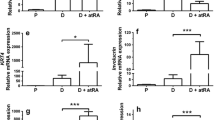Abstract
A retinoic acid (RA) inducible skin-specific gene transcript (RIS-1) was isolated by differential hybridization screening of a RA-treated human skin cDNA library. The library was constructed from pooled RNA derived from normal adult human skin treated with alltrans-RA for 4 h (n=6) and 12 h (n=6)in vivo. RIS-1 cDNA corresponded to a 0.6 kb transcript that was barely detectable in normal adult human skin but was significantly induced by 8 h in RA-treated compared to vehicle-treated skin (range 1.1–3.6 fold). Prolonged RA treatment for up to 24 h further increased relative RIS-1 mRNA levels by 1.3–5.5 fold. HPLC analysis of the RA content of 0.1% RA-treated skinin vivo revealed significant levels at 6 h (18.8–120.6 ng RA/g wet weight tissue; approximately 240 nM), immediately preceding the time point at which the increased RIS-1 mRNA level was first seen. This concentration of RA also induced the mRNA levels for cellular RA binding protein II (1.6–19 fold), a marker of RA activity in human skin. RIS-1 mRNA was detected by Northern and dot blotting only in normal skin but not in any other normal human tissues examined, indicating a tissue-specific pattern of gene expression. RIS-1 transcripts were detected at very low levels in untreated cultured human epidermal keratinocytes, while no expression was seen in dermal fibroblasts and melanocytes, the other major cell types in skin. Southern analysis of human and mouse DNA indicated the existence of evolutionarily conserved sequences for RIS-1 between these two species. The polypeptide sequence derived from the partial RIS-1 cDNA was found to be identical to the calcium binding domain found in ‘psoriasin’, a gene whose expression appears to be increased in the skin of psoriasis patients.
Similar content being viewed by others
Abbreviations
- RIS-1:
-
retinoci acid-inducibleskin-specific gene
- RA:
-
All-trans retinoic acid
References
Fisher JG, Esmann J, Griffiths CEM, Talwar HS, Duell EA, Hammerberg C, Elder JT, Karabin GD, Nickoloff BJ, Cooper KD & Voorhees JJ (1991) J. Invest. Dermatol. 96: 699–707.
Saurat J-H (1989) in: Pharmacology of Retinoids in Skin (Reichert U and Shroot B, eds), vol. 3, pp. 215–226, Basel, Krager
Petkovich M, Brand NJ, Krust A & Chambon P (1987) Nature 330: 444–450
Gigueref V, Ong ES, Segui P & Evans RM (1987) Nature 330: 624–629
Hoffmann B., Lehmann JM, Zhang XK, Hermann T, Husmann M, Graupner G & Pfahl M (1990) Mol. Endo. 4, 1727–1736
Dolle P, Ruberte E, Kastner P, Petkovich M, Stoner CM, Gudas IJ & Chambon P (1989) Nature 342, 702–705
Tavakkol A, Griffiths CEM, Keane KM, Palmer RD & Voorhees JJ (1992) J. Invest. Dermatol. 99, 146–150
Redfern CPF & Todd C (1992) J Cell Sci. 102, 113–121
Elder JT, Åström A, Tavakkol A, Krust A, Kastner P, Chambon P & Voorhees JJ (1992) J. Invest. Dermatol. 98, 36S-41S
Ong DE & Chytil F (1978) J. Biol. Chem. 253, 4551–4554
Nilsson MHL, Spurr NK, Saksena P, Busch C, Norlinder H, Peterson PA & Sundelin J (1988) Biochemistry 173, 45–51
Åström A, Tavakkol A, Peterson U, Cromie M, Elder JT & Voorhees JJ (1991) J Biol Chem 266, 17662–17666
Eller MS, Oleksiak MF, McQuaid TJ, McAfee SG & Gilchrest BA (1992) Exp. Cell. Res. 199, 328–336
Reynolds NJ, Fisher GJ, Griffiths CEM, Tavakkol A, Talwar HS, Rowse PE, Hamilton TA & Voorhees JJ (1993) J. Pharmacol. Exp. Therap. 266, 1636–1642
Maden M, Ong DE, Summerbell D & Chytyl F (1988) Nature 335, 733–735
Bedo G, Santisteban P & Aranda A (1989) Nature (London) 339, 231–234
Lucas PC, O'Brein RM, Mitchell JA, Davis CM, Imai E, Forman BM, Samuels HH & Granner DK (1991) Proc. Natl. Acad. Sci. USA 88, 2184–2188
LaRosa GJ & Gudas LJ (1988) Proc. Natl. Acad. Sci. USA, 85, 329–333
Duester G, Shean MI, McBride MS & Stewart MJ (1991) Mol. Cell. Biol. 11, 1638–1646
Gudas LJ (1992) Cell Growth Diff 3, 652–662
Duell ED, Åström A, Griffiths CEM, Chambon P & Voorhees JJ (1992) J. Clin. Invest. 90, 1269–1274
Lowry OH, Rosebrough NJ, Farr AL & Randall RJ (1951) J. Biol. Chem. 193, 265–275
Zouboulis CC & Tavakkol A (1994) BioTechniques 16, 290–294
Laborda, J (1991) Nucl. Acids Res. 19, 3998
Danielson PE, Forss-Petter S, Brow MA, Calavetta L, Douglass J, Milner RJ & Sutcliffe JG (1988) DNA 7, 261–267
Gonzalez IL, Gorski JL, Campen TJ, Dorney DJ, Erickson JM, Sylvestor JE & Schmickel RD (1985) Proc. Natl. Acad. Sci. USA 82, 7666–7670
Sambrook J, Fritsch EF & Maniatis T (1989) Molecular Cloning: A laboratory Manual, 2nd Ed., (Cold Spring Harbor, New York
Elder JT, Cromie M, Griffiths CEM, Chambon P & Voorhees JJ (1993) J Invest Dermatol 100, 356–359
Madsen P, Rasmussen HH, Leffers H, Honore B, Dejgaard K, Olsen E, Kiil J, Walbum E, Anderson AH, Basse B, Lauridsen JB, Ratz GP, Celis A, Vandekerckhove J & Celis JE (1991) J. Invest. Dermatol. 97, 701–712
Kretsinger RH (1987) Cold Spring Harbor Symposia on Quantitative Biology 52, 499–510
Durand B, Saunders M, Leroy P, Leid M & Chambon P (1992) Cell 71, 73–85
Anger T (1991) Contact Dermatitis 25, 108–114
Proksch E, Feingold KR, Mao-Qiang M & Elias PM (1991) J. Clin. Invest. 87, 1668–1673
Marks R, Hill S & Barton SP (1990) Br. J. Dermatol. 123, 457–466
Kodomatsu K, Tomokura M & Muramatsu T (1988) Biochem. Biophys. Res. Commun. 151, 1312–1316
Suva II, Ernst M & Rodan GA (1991) Mol. Cell. Biol. 5, 2503–2510
Angel P, Allegretto EA, Okino ST, Hattori K, Boyle WJ, Hunter T & Karin M (1988) Nature 332, 166–171
Sitzmann J, Algermissen B, Czarnetzki BM & LeMotte P (1993) J. Invest. Dermatol. 100, 220
Author information
Authors and Affiliations
Rights and permissions
About this article
Cite this article
Tavakkol, A., Zouboulis, C.C., Duell, E.A. et al. A retinoic acid-inducible skin-specific gene (RIS-1/psoriasin): molecular cloning and analysis of gene expression in human skinin vivo and cultured skin cellsin vitro . Mol Biol Rep 20, 75–83 (1994). https://doi.org/10.1007/BF00996356
Received:
Accepted:
Issue Date:
DOI: https://doi.org/10.1007/BF00996356




